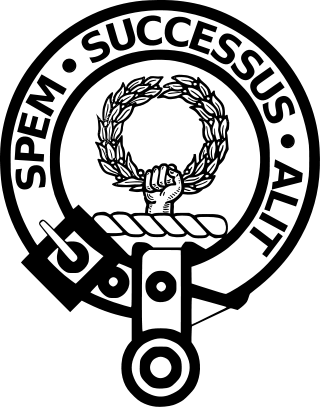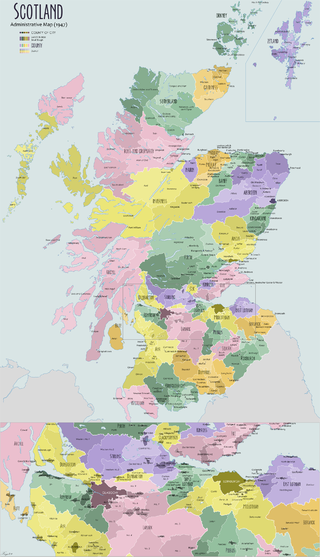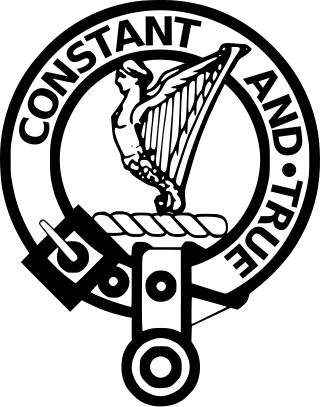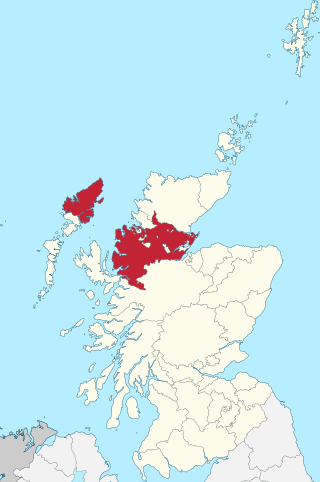
Clan Ross is a Highland Scottish clan. The original chiefs of the clan were the original Earls of Ross.

Cromartyshire was a county in the Highlands of Scotland, comprising the medieval "old shire" around the county town of Cromarty and 22 enclaves and exclaves transferred from Ross-shire in the late 17th century. The largest part, six times the size of the old shire, was Coigach, containing Ullapool and the area north-west of it. In 1889, Cromartyshire was merged with Ross-shire to become a new county called Ross and Cromarty, which in 1975 was merged into the new council area of Highland.

The Shires of Scotland, or Counties of Scotland, were historic subdivisions of Scotland.

Ross and Cromarty, is an area in the Highlands and Islands of Scotland. In modern usage, it is a registration county and a lieutenancy area. Between 1889 and 1975 it was a county.

Clan Rose is a Scottish clan of the Scottish Highlands.

Ross-shire, or the County of Ross, was a county in the Scottish Highlands. It bordered Sutherland to the north and Inverness-shire to the south, as well as having a complex border with Cromartyshire, a county consisting of numerous enclaves or exclaves scattered throughout Ross-shire's territory. The mainland had a coast to the east onto the Moray Firth and a coast to the west onto the Minch. Ross-shire was named after and covered most of the ancient province of Ross, and also included the Isle of Lewis in the Outer Hebrides. The county town was Dingwall.
Robert Mor Munro, 15th Baron of Foulis, and 18th chief of the Clan Munro was a 16th-century Scottish chief. He was known as Robert Mor on account of his large stature. He was the eldest son of Robert Munro, 14th Baron of Foulis. Although this Robert Munro is traditionally 15th Baron and 18th overall chief of the clan, he is only the 8th Munro chief that can be proved by contemporary evidence.
The Sheriff of Ayr was historically the royal official responsible for enforcing law and order in Ayr, Scotland and bringing criminals to justice. Sundrum Castle was used by the sheriff from the 14th century, and Loudoun Castle from the 16th century. Prior to 1748 most sheriffdoms were held on a hereditary basis. From that date, following the Jacobite uprising of 1745, the hereditary sheriffs were replaced by salaried sheriff-deputes, qualified advocates who were members of the Scottish Bar.
A sheriffdom is a judicial district of Scotland. Originally identical to the Shires of Scotland, from the eighteenth century many counties were grouped to form "sheriffdoms".
The Sheriff of Bute was historically the office responsible for enforcing law and order on the Isle of Bute, Scotland and bringing criminals to justice.
John Munro, 2nd of Lemlair was a Scottish soldier who fought as a colonel in the Wars of the Three Kingdoms. His seat was at Lemlair House.
Nairnshire was a constituency of the Parliament of Scotland before the Union with England in 1707. The barons of the shire or sheriffdom of Nairn elected two commissioners to represent them in the Parliament and in the Convention of Estates.
The Sheriff of Inverness was historically the office responsible for enforcing law and order and bringing criminals to justice in Inverness, Scotland. Prior to 1748 most sheriffdoms were held on a hereditary basis. From that date, following the Jacobite uprising of 1745, the hereditary sheriffs were replaced by salaried sheriff-deputes, qualified advocates who were members of the Scottish Bar.
The Sheriff of Elgin was historically the royal official responsible for enforcing law and order in Elgin, Scotland. Prior to 1748 most sheriffdoms were held on a hereditary basis. From that date, following the Jacobite uprising of 1745, they were replaced by salaried sheriff-deputes, qualified advocates who were members of the Scottish Bar.
The Sheriff of Caithness was historically the royal official responsible for enforcing law and order in Caithness, Scotland.

Baron of Muirton is a title of nobility in the Baronage of Scotland.
This article collects the History of Nairn, Nairn is a town and Royal burgh in the Highland council area of Scotland. It is an ancient fishing port and market town around 17 miles (27 km) east of Inverness. It is the traditional county town of Nairnshire.

Hugh Rose, 15th Baron of Kilravock and Chief of Clan Rose, (1663–1732) was one of the Scottish representatives to the first Parliament of Great Britain as MP for Nairnshire.

Hugh Rose, 16th Baron of Kilravock (1684-1755) was a Member of Parliament for Ross-shire and Chief of Clan Rose. The eldest son of Hugh Rose, 15th of Kilravock, he inherited his father's estates and the Clan Chiefdom on his father's death in 1732.
Thomas Mackenzie of Pluscarden, also known as of Pluscardine was a Scottish soldier and member of parliament of the 17th century. He was a member of the Clan Mackenzie, a Scottish clan of the Scottish Highlands.








